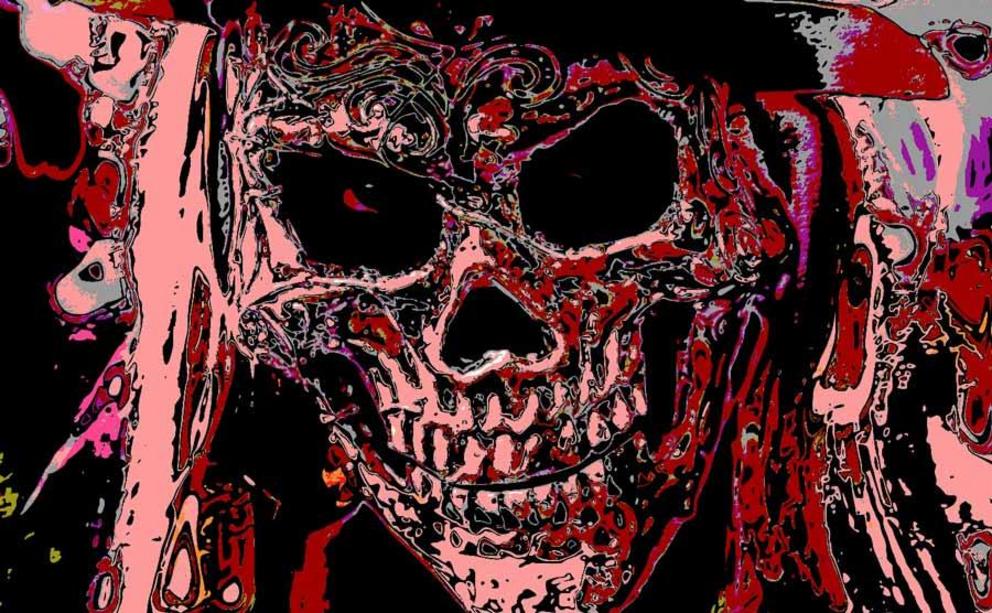Zombies and voodoo: the living dead religion of modern Haiti
Top image: The smile of death in the ancient land of Haiti leads to conversations about zombies and Voodoo, both of which are still living beliefs.
On the list of the most well-known monsters from Hollywood movies, zombies clearly occupy one of the top positions. In their cinematographic version, they consume human flesh and brains with the explanation that this fact diminishes their pain of being dead, while humans bitten or hurt by zombies end up becoming zombies as well. In Haiti, zombies not only exist in movies, but as a day-to-day reality that is steeped in Voodoo, which revolves around spirits known as lwa. In Haitian Voodoo (or Haitian Vodou) the Iwa spirits get their names and attributes from traditional West and Central African divinities, and they are also equated with certain Roman Catholic saints.
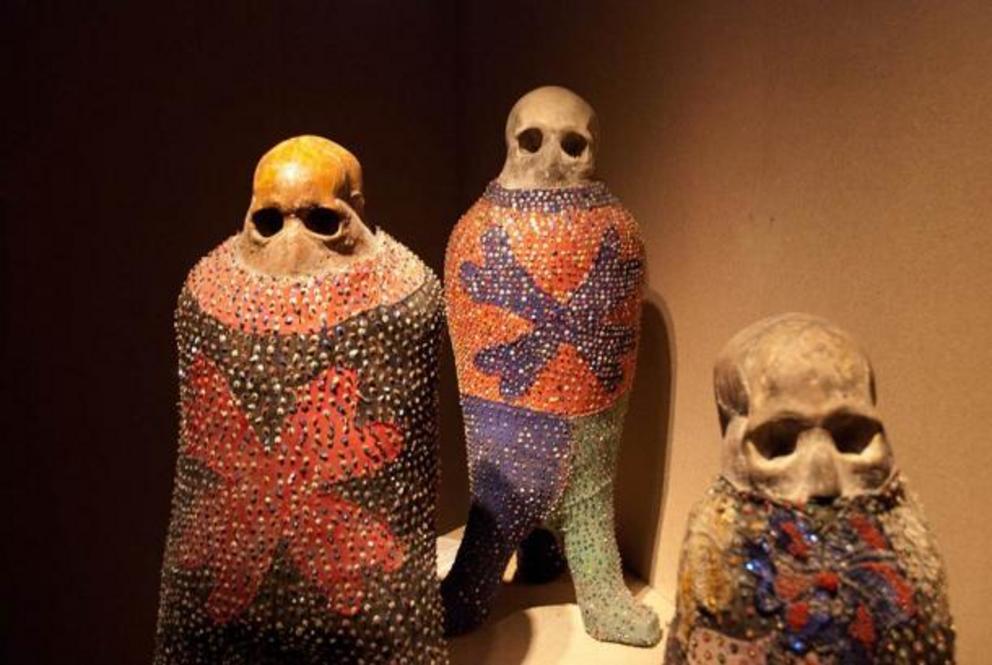 The ideas behind Voodoo and zombies in Haiti come from African religious beliefs and rituals symbolized by these Haitian ritual objects on display at the Ethnographic Museum in Berlin.
The ideas behind Voodoo and zombies in Haiti come from African religious beliefs and rituals symbolized by these Haitian ritual objects on display at the Ethnographic Museum in Berlin.
Haitian History And the World of Zombies and Voodoo
Haiti, the first black republic, is distinguished by colonialism, poverty, zombies, and Voodoo. Situated in the Caribbean and with its capital at Port-Au-Prince, this country continues to be dominated by the existence of gangs and corruption, and the silence of the night is often interrupted by gunshots and by violent thunderstorms. The harsh living conditions in this island nation have reduced the medium life expectancy to just 43 years. Even though life goes on, just like business, each morning brings forth the necessity to clean the streets after the confrontations of the night.
The Spanish arrived in Haiti in the year 1492 and they exterminated the local indigenous population in less than ten years. Taking into consideration the fact that the Industrial Revolution had not occurred yet, slaves continued to be in high demand and colonial Haiti quickly got involved in this horrible industry. In roughly 1503, the Catholic priest Bartholomeo de las Casas came up with the idea of bringing slaves to Haiti from Africa. After this, the French rulers of Haiti, in turn, followed the Spanish model and they continued to bring slaves from Africa to Haiti with the purpose of making them work on plantations.
Around the year 1801, various slave revolts against the colonizers began to develop. The local rebel army was led by Jean Jacques Dessalines, who was aiming for Haitian independence. Haiti was the first Caribbean colony to gain independence, which the slave revolt achieved in 1804. But the concepts of the Voodoo religion that came with the slaves from certain parts of Africa lived on in Haiti and so did the folkloric belief in zombies.
Three hundred years after the end of slavery in Haiti the nation is still tormented by inequality and poverty. An interesting case took place in 1982, when a man was arrested who killed people and supplied many hotels from Petion Ville with human flesh to be cooked and consumed. In only a few days, the individual escaped and was never captured again.
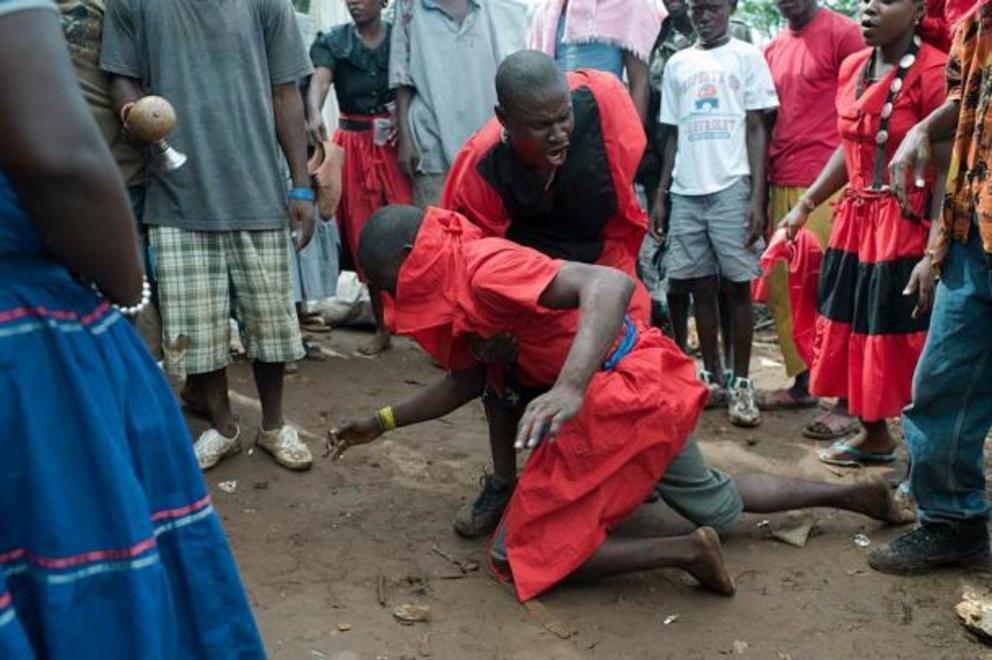 A houngan Voodoo priest ritual in Haiti based on the religious beliefs of the Kingdom of Dahomey in the present-day Benin Republic of Africa.
A houngan Voodoo priest ritual in Haiti based on the religious beliefs of the Kingdom of Dahomey in the present-day Benin Republic of Africa.
Priests, Voodoo and Festivals
Haitian Voodoo constitutes a religion centered around one main god alongside whom a multitude of Iwas (or Loas) exist, which are entities in the form of energy spirits which help humans entering into contact with Voodoo. One thing Voodoo adepts desire is to become possessed by such spirits which induce the state of loss of self with the purpose of being consumed by a higher power.
In Haitian Voodoo animal sacrifices are offered to these spirits. The explanation is that, in the moment of the animal's death an energy is released which can feed those present on a spiritual level. In this way, that which is received from the sacrifice constitutes the purpose of performing the ritual.
Many annual Voodoo celebrations take place in Haiti. And, regardless of the conditions, celebrating these ritualized festivals is never stopped for any reason. An example of this is the Haitian version of the Day of the Dead (Dia de los Muertos). Throughout the duration of this festival, locals dance in cemeteries and they can be observed wearing double sunglasses, which symbolize life and death.
In Voodoo, priests are called “houngan." They perform their activity in “peristyle" temples where receiving people is done through the act of pouring water on the floor. Everything has a positive (good) or a negative (evil) meaning. The West offers the concept of the good-evil division , while Voodoo does not present this separation. Voodoo recognizes and uses both sides.
A houngan has the possibility to use spirits in order to help individuals, while a bokor, a priest who can practice black magic , has the possibility of also dealing with spells and curses. In Voodoo, the bokor is preoccupied by both the positive and the negative side. He serves the Voodoo spirits with both hands.
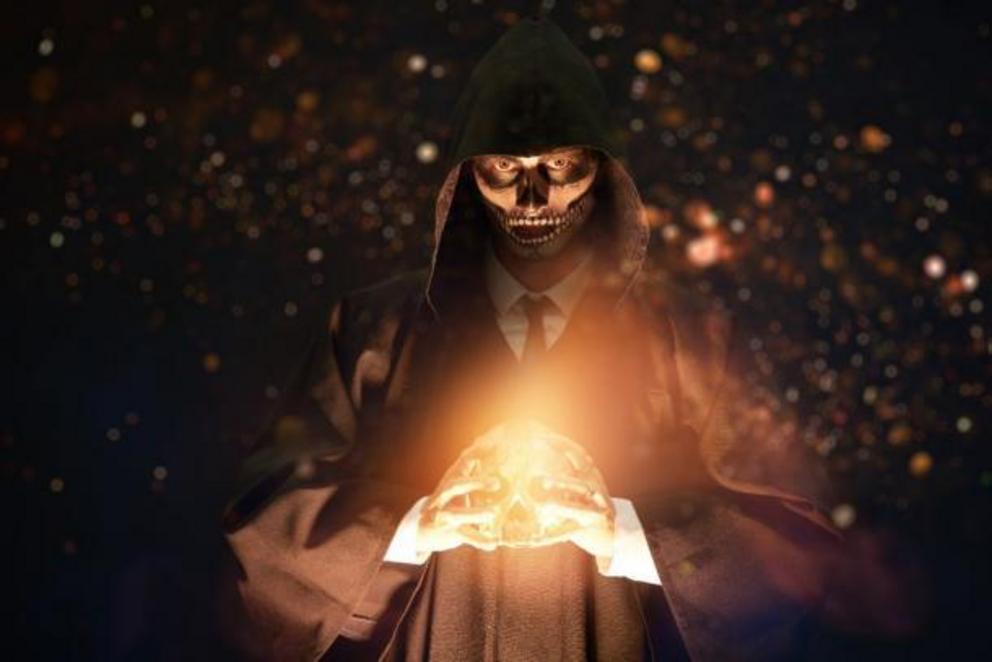 In Haiti today Voodoo and the creation of zombies continues to be the work of secret societies and rituals.
In Haiti today Voodoo and the creation of zombies continues to be the work of secret societies and rituals.
Voodoo, Secret Societies, and Zombies On Demand!
Voodoo also refers to the existence of astral zombies. These entities are spirits captured by priests who use them. By using these spirits priests can offer help to individuals who wish to obtain large financial gains, or they can be cursed and used for evil purposes. Just like in the situation of the living dead, zombies appear in the form of humans who are physically still alive, but whose eyes indicate in a clear way that life has left their body.
There are not too many conversations about zombies in Haiti that can be overheard in daily life, because zombification, the process of creating a zombie, is an illegal procedure. But there are several secret societies in Haiti that keep the zombie world under control locally. These societies act like a spiritual justice system, and sometimes their verdicts are powerful and irrevocable.
There are also secret societies in Haiti that practice “makanda," the most violent form of Voodoo black magic. During the war of independence (1801-1804), fighters that poisoned and killed the white colonizers were already practicing this form of black magic. In certain situations, when someone must be punished, but not killed, the secret societies could transform the individual into a zombified slave and use him for forced labor.
Zombification results in the elimination of individuality and a lifetime of slavery commanded by a single master. The master treats the zombie as a sub-human. These days, the Haitian mafia demand sums of around 2000 American dollars for a zombie slave, along with the guarantee of protection from government authorities like the police.
 A depiction of a zombie by artist Jean-noël Lafargue at twilight in a field of sugar cane in Haiti, called forth by the Voodoo master.
A depiction of a zombie by artist Jean-noël Lafargue at twilight in a field of sugar cane in Haiti, called forth by the Voodoo master.
Zombification
In Haiti there have been numerous cases of zombification that have been reported on. The process of zombification is structured in four main stages.
The first stage refers to the trial. When the respected offended person wants to seek justice, that person will go to a bokor to be avenged. That bokor has the obligation to meet the other bokors who are more advanced in rank or in age. Together, they will judge the case and reach a final decision. In cases when the individual's request is heeded, the zombification process will be applied and the bokor gathering will proceed by preparing the specific poison.
Poisoning represents the second stage of the zombification process. These poisons are very powerful and can be administered via inhalation, swallowing or touch. The poison recipe is the greatest secret of the zombification process. Known ingredients include dried frogs, various substances, dried plants, human bones minced into powder, poison ivy, and the toxin of the puffer fish. Puffer fish are famous in Japan as they are a culinary delicacy but must be specially prepared by a trained chef to avoid the toxic poison in the fish’s internal organs. Each year, the consumption of this fish results in three or four deaths in Japan, and many others suffer severe consequences requiring medical aid.
Once the poison has been administered the soon to be zombie goes through convulsions and stomach cramps followed by the effect of the neuro-toxin from the puffer fish which makes the individual seem dead. If the correct poison dosage is used, the toxin has the effect of reducing the human metabolism to the point where the individual seems dead.
It is very difficult for someone to understand that the poisoned individual still lives. Haiti does not have a very well-developed medical system, and thus the poisoned individual is easily declared dead and taken to the morgue.
Even though, looking from the outside, the individual seems dead, he is aware of his surroundings. He understands that he is being buried, he hears his loved ones crying, he hears the sealing of the lid of the coffin and the way in which the earth from the shovel falls on top of it. But the zombie cannot move or utter a single word. In this way, the person is buried alive, but the individual does not suffocate because his metabolism is slowed to the point in which the brain no longer needs too much oxygen.
Waking the deceased is the third stage of the zombification process. This is represented by the bokor master, or someone appointed by him digging up the “seemingly dead” man. The time up to the moment of digging up the individual can vary from a few days to a week, during which the poison takes effect and induces severe cerebral lesions. As a result, the person is deprived of will and personality and the individual becomes the slave of the bokor.
In the medical world, the disease called catatonic schizophrenia can make an individual seem dead and zombie-like, but it is treatable. However, the victim of the Haitian zombification process cannot be cured.
Continuous slavery is the final stage of the zombification process, a context in which the person has nothing left of his previous life and can only live on as a zombie. To remain alive a zombie must never consume salt. Moreover, the bokor must give the zombie something meant to keep its blood pressure at a low level. This stage of permanent slavery can only end with either the revolt of the zombie or with the death of the bokor. As a zombie no longer has a will, the cases of revolt are extremely rare.
 A typical scene at the Voodoo "power object" market in Lomé, Togo, in a photograph by Dominik Schwarz from 2008.
A typical scene at the Voodoo "power object" market in Lomé, Togo, in a photograph by Dominik Schwarz from 2008.
Spirits from the World Beyond
Voodoo is not reduced solely to the creation of zombies. This originally African religious belief system dates back more than 7000 years, making it one of oldest religions in the world. The activity of the bokors and of the houngans is not just tolerated, but they are visited and consulted by the authorities. As 97% of all the Haitian population believes in Voodoo, witchdoctors are just as valuable as medical doctors.
In addition, white people fear makumba black magic. According to ethnographer Alfred Metraux in a quote from 1959:
“The horror which I have encountered at the white people of Haiti can be explained through a kind of revenge of the former slaves: mistreated for generations, they have used their occult powers to terrify their former tyrants. The fear which reined on all the plantations from Haiti was deeply rooted in the souls: it was the horror in front of the magical power of Africa, which disturbed the sleep of slave masters.”
One of those interested in Haiti and Voodoo was the Spanish scholar Juan Jose Revenga who traveled to both Haiti and Africa with the purpose of documenting and finding out as many things as possible about these religious beliefs. He was the witness of a memorable ceremony in Haiti’s Jebe village, which he describes in the following way:
“I saw that most of the doors on which a fetish had been hung were open. Somebody told me that those clay puppets, having a height of about half a meter, were the spirits which were about to make the engun-gu dance, entering beneath them and raising them up in the air with all their might. The music started in a frenetic rhythm. All drank and danced, preparing themselves for that which was about to follow. In that moment the engun-gu appeared, dancing in a circle and surrounding all the audience gathered there. They were like some huge cones, covered to the ground in colored natural fibers and having goat horns on their foreheads. It was explained to me that they represented the ghosts of the past come to the world of the living. […] After those demonstrations, the priests got up walking in turns to the engun-gu. These were waiting for them calmly staying in the square, after which they spit various potions over them and addressed them in old African languages. When they finished with the last of them, they all began again to dance in a circle, until they suddenly stopped, and their helpers raised from the ground the straw cones, under which I expected to discover a man moving the puppet. But underneath it there was nothing but a fetish with a demon face and no man. In the authentic ceremonies the puppet is always animated solely by a fetish. As attentive as I had been, I never managed to see anyone coming out from under the engun-gu. As soon as they placed it back standing on top of the fetish, it began to dance again. Pure and simple, beneath the engun-gu there was nothing else than the horned puppet moving it, and, when they saw it, the villagers began to scream in fear."
The beliefs from the area mention the fact that whenever an engun-gu touches a person, that individual is soon taken away to the world of darkness.
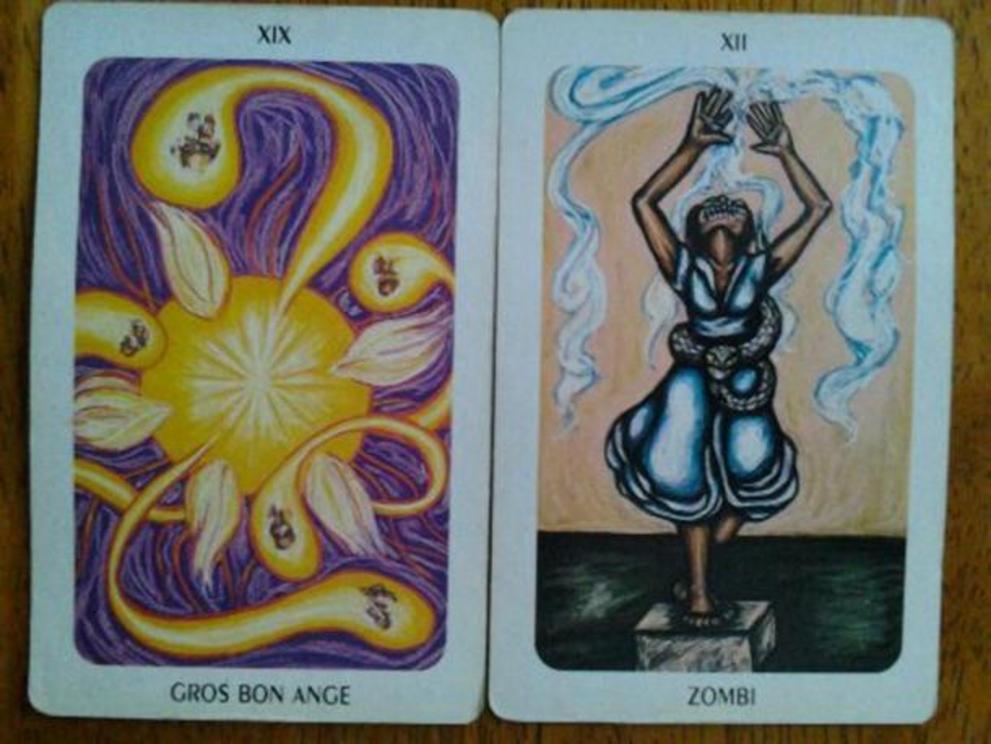 Voodoo cards depicting the Gros-bon-ange or The Big and Good Angel and a zombie.
Voodoo cards depicting the Gros-bon-ange or The Big and Good Angel and a zombie.
Puppets and Death
In Voodoo, the belief referring to the human soul is a dual one, meaning the soul has two parts: the Gros-bon-ange (The Big and Good Angel) and the Ti-bon-ange (The Small Good Angel). The first part denotes the protective spirit that at the moment of death detaches itself from the body, and the second part defines the totality of the person's deeds. The family of the deceased is obliged a year after his death to perform the ritual of “the extraction from the bottom of the water."
As a result of this ritual, the Ti-Bon-Ange is summoned back from the place where it retired. It is then retrieved and contained inside a “govi" vessel, a specially prepared vessel meant to replace the body and in which the members of the family can bring the deceased back home in order to serve as a protective spirit. If a bokor steals such a vessel, he can submit the spirit of the deceased to torments on the other side or he can use it for evil purposes.
Voodoo recognizes a lot of Loas from which one can mention here Damballah (the Loa presiding over flowing water), Erzulie (The Black Maiden), Baron Samedi (the spirit of death), and Legba (the Loa that protects sorcerers).
For the purpose of realizing an action at a distance on a certain person, a bokor must enter a trance in such a way as to become possessed by that Loa which he has invoked. In this way, the soul of the bokor is temporarily replaced by the spirit of the respective Loa. In consequence, the bokor can travel spiritually without restrictions and he can cause any kind of harm including death.
In other cases, a puppet can be created which looks similar to the victim and on which something which belonged to the victim is placed. The bokor then performs a series of invocations addressed to Baron Samedi, another Loa, after which he can do things to the puppet that will also happen to the victim.
Today, Voodoo shows no signs of disappearing from Haiti. On the contrary, Voodoo’s various aspects continue to thrive in folkloric Haitian society and continue to fuel new Hollywood movie scripts about zombies.

